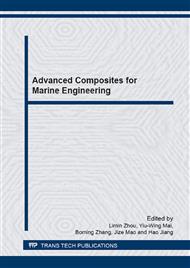p.140
p.147
p.152
p.161
p.169
p.181
p.188
p.194
p.202
Investigation of Tensile Strength of Composite Laminate under Diverse Environment Conditions
Abstract:
To investigate ocean environmental effects of salt water and xenon light, salt water spray test and xenon test were performed on long immersion hours. CFRP (Carbon Fiber Reinforced Polymer) specimens were prepared for salt water spray experiment, xenon light exposure experiment and mechanical tensile tests. The composite specimens with total 15 layers were manufactured with diverse fiber orientations of [0°]15, [90°]15 and [0°3/+45°2/-45°2/90°/-45°2/+45°2/0°3]. After applying environmental conditions, the tensile strength was compared with the tensile strength without environmental conditions. The influence of different fiber orientation was also investigated, respectively. Finally, the results showed that the tensile strength of composite specimens was affected by salt water and xenon light clearly.
Info:
Periodical:
Pages:
169-180
Citation:
Online since:
March 2015
Authors:
Price:
Сopyright:
© 2015 Trans Tech Publications Ltd. All Rights Reserved
Share:
Citation:


